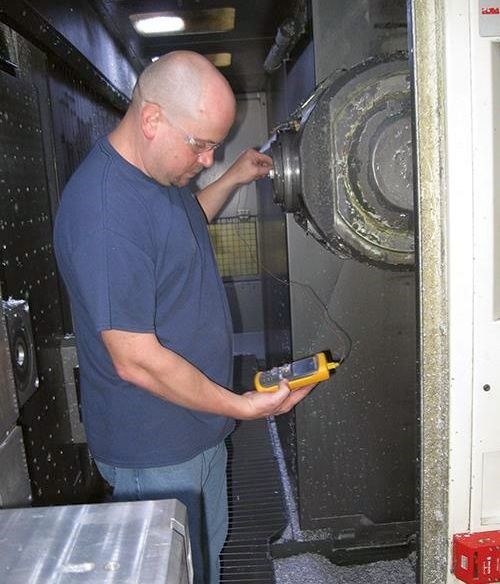The Subtle Clue That a Spindle Is About to Fail
A shop that regularly replaces its spindles found the indicator predicting when this replacement would be needed.
Share


Takumi USA
Featured Content
View More
Hwacheon Machinery America, Inc.
Featured Content
View More






Tech Manufacturing runs the spindles hard on its five-axis profilers. The Missouri shop uses these machines to take heavy cuts at high speed for machining large aircraft parts. Periodic spindle replacement is a fact of life and an acceptable cost for this shop.
But the problem was that spindle failure was occurring by surprise. Analysis of machine performance data revealed spindle replacement to be the leading cause of unplanned maintenance downtime for the shop. If this event could instead be planned maintenance downtime, so the shop could schedule spindle replacement within its workflow, then that change would represent a meaningful efficiency improvement. In short, the shop needed to find a way to predict that a spindle was about to fail.
The team members here searched for the telling clue. They tried periodic tap testing. They tried drawbar force tests.
The reliable indicator proved to be temperature.
Just after a milling cycle, the temperature inside one of the profiler’s spindle tapers is generally about 120°F (49°C). But observation of this temperature over time revealed that it reliably increases as the spindle begins to near the end of its life. The increase comes early enough that the shop has time to order a new spindle and schedule the needed replacement.
Now, the shop watches this indicator. Employees routinely measure spindle temperature in search of this increase. They use a digital thermometer for this measurement, but it is possible that this precise device is not even needed. Now that the team members running the profilers are aware of this effect, they can often detect it in the heat of the toolholders when they are manually changing out tools between jobs.
Transforming unplanned spindle replacement into planned maintenance was part of a broad process improvement effort for Tech Manufacturing. Read more about that effort.
Related Content
-
Inverting Turning and Five-Axis Milling at Famar
Automation is only the tip of the iceberg for Famar, which also provides multitasking options for its vertical lathes and horizontal five-axis machine tools.
-
CNC Machine Shop Honored for Automation, Machine Monitoring
From cobots to machine monitoring, this Top Shop honoree shows that machining technology is about more than the machine tool.
-
How to Determine the Currently Active Work Offset Number
Determining the currently active work offset number is practical when the program zero point is changing between workpieces in a production run.


























.png;maxWidth=150)





.jpg;maxWidth=300;quality=90)





